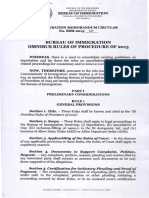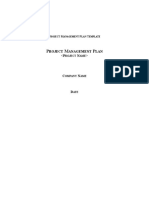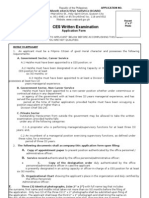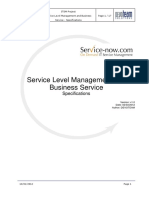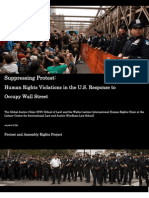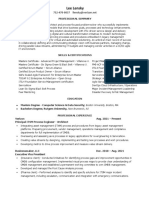At a glance
Powered by AI
The key takeaways are that a project charter outlines the project description, objectives, stakeholders, vision, scope, assumptions, dependencies, constraints, milestones, risks, resources, and approvals.
Project Charter for <Project>
Version 1.0 approvedPrepared by <author><organization><date created>
Copyright © 2007 by Karl E. Wiegers. Permission is granted to use and modify this template.
Project Charter for Project!Page ii
Table of Contents
1. Project Description........................................................................................................12. Business Objectives and Success Criteria.....................................................................13. Stakeholders...................................................................................................................14. Vision.............................................................................................................................1. Project Scope.................................................................................................................2!. "ssu#ptions and Dependencies....................................................................................2$. Constraints.....................................................................................................................2%. &ilestones......................................................................................................................3'. Business (isks...............................................................................................................31). (esources.......................................................................................................................311. "pprovals.......................................................................................................................4(evision *istor+..................................................................................................................
Project Charter for Project!Page "
1.Project Description
<Provide a concise summary of the intent and motivation for the project. This section could describe the business opportunity that the project is intended to create or exploit. There might be a specific final deliverable or goal to call out. You could incorporate a summary of the business case that explains why the organization wants to undertake the project.
2.Business Objectives and Success Criteria
<!escribe the important business objectives of the product in a way that is "uantitative and measurable. These could include revenue increase# cost savings# return on investment# or target release dates. !etermine how success will be defined and measured on this project. !escribe the factors that are likely to have the greatest impact on achieving that success. $stablish measurable criteria to judge whether project has met its business objectives.
3.Stakeholders
<%takeholders are individuals# groups# or organizations that are actively involved in a project# are affected by its outcome# or can influence its outcome. The stakeholder profiles identify the project sponsor# project manager# customers for this product# and other stakeholders. &dentify business'level customers# target market segments# and significant user classes. (or each stakeholder category# describe the major benefits they will receive from the product# their likely attitudes toward the project# what constitutes a win or success for the stakeholder# and any known constraints that must be accommodated. You might include a table that lists affected business areas and organizations and describes the impact the project will have on them.
StakeholderMajor BenefitsAttitudesWin ConditionsConstraints
Project Sponsor Project Manager User Class #1User Class #netc.
.!ision
<)rite a concise vision statement that summarizes the purpose and intent of the project and describes what the world will be like when the project is completed. The vision statement should reflect a balanced view that will satisfy the needs of diverse customers as well as those of the developing organization. &t may be somewhat idealistic# but it should be grounded in the realities of existing or anticipated customer markets# enterprise architectures# organizational strategic directions# and cost and resource limitations. *onsider using the following template+
For
,target customer-
Who
,statement of the need or opportunity-
The
,product name-
Is a
,product category-
Project Charter for Project!Page 2
That
,key benefit# compelling reason to buy or use-
Unlike
,primary competitive alternatives# current system# or current business process-
Our product
,statement of primary differentiation and advantages of new product or service-
".Project Scope
<The project scope defines the range of the proposed products and services the project will deliver. %cope can be represented using a context diagram# an event list# andor a feature table.%cope might be subdivided into the scope of the initial product release and planned growth strategies for subse"uent releases. &t/s also important to define what the project will
not
include#so describe limitations and exclusions# such as product features or characteristics that a stakeholder might anticipate# but which are not planned to be included in the project.
#.$ssu%ptions and Dependencies
<0ecord any assumptions that were made ,as opposed to known facts- when conceiving the project. 1ote any major external dependencies the project must rely upon for success# such as specific technologies# third'party vendors# development partners# or other business relationships. 2lso identify any other projects that are related to this project in some way or may have a bearing on its outcome. 3ive each item a uni"ue identifier# like those shown below.
"S,1-D,1-
&.Constraints
<&dentify known project constraints# such as products to be reused# components to be ac"uired#interfaces to other projects or products# or technologies to be employed. !escribe the priorities among the project/s features# "uality objectives# schedule# staff# and budget. The following tableidentifies the parameters around the project/s key drivers ,top priority objectives-# constraints to work within# and dimensions that can be balanced against each other to achieve the drivers within the known constraints. $xample+
DimensionConstraint state limits!Dri"er state o#jecti"e!De$ree of Freedomstate allo%a#le ran$e!
Features
70-80% of high priority features ust !e inclu"e" in release 1.0
Quaity
0-$% of user acceptance tests ust pass for release 1.0 $-8% for release 1.1
Cost
!u"get o&errun up to 1$% accepta!le 'ithout e(ecuti&ere&ie'
!chedue
release 1.0 to !e a&aila!le !y 10)1 release1.1 !y 1*)1
!taff
a(iu tea si+e is , "e&elopers testers

















